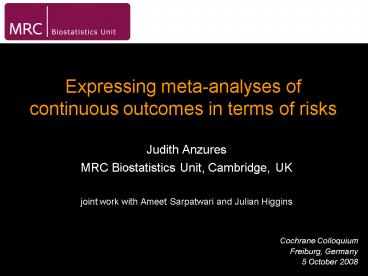Expressing metaanalyses of continuous outcomes in terms of risks
1 / 22
Title:
Expressing metaanalyses of continuous outcomes in terms of risks
Description:
Let L be the proportion of the distribution that is less than a cut-point L ... Difference between two logits for a common cut-point for two groups with means ... –
Number of Views:50
Avg rating:3.0/5.0
Title: Expressing metaanalyses of continuous outcomes in terms of risks
1
Expressing meta-analyses of continuous outcomes
in terms of risks
- Judith Anzures
- MRC Biostatistics Unit, Cambridge, UK
- joint work with Ameet Sarpatwari and Julian
Higgins
Cochrane Colloquium Freiburg, Germany 5 October
2008
2
Outline
- Measuring a continuous outcome, but reporting a
binary one - Methods for transforming mean differences (MD) or
standardised mean difference (SMD) into odds
ratio (OR)? - Alzheimers disease example
- Simulation study
- Conclusions
3
Aim assess the effect of reduction in salt
intake on blood pressure. Outcome measure mean
difference between treatment and control groups.
4
Aim assess the effect of reduction in salt
intake on blood pressure. Outcome measure mean
difference between treatment and control groups.
?C
?T
Select a cut-point
- Calculate
- Odds ratio
- Relative risk
- Risk difference
Systolic blood pressure
5
Interpretation of results
- Many argue that continuous outcomes are no use in
clinical practice - Mean difference (MD) may be meaningful if the
scale is well known (e.g. weight loss)? - SMDs difficult (Cohens criteria Hedges
adjustment)? - Risks are much preferred, allegedly
- Established cut-points are occasionally available
- haemoglobin gt 13g/ml anaemia
- BMI gt 30 kg/m2 obesity ?
- For most outcomes, such cut-points are not
available
6
Summary of findings table
Effects of salt reduction in blood pressure
Patients or population Adults with elevated
blood pressure, irrespective of gender and
ethnicity. Settings Europe, USA and Australia
Intervention Reduced salt intake Comparison
Usual salt intake
?
7
Two possibilities, leading to four methods
- We can convert from an SMD to on OR
- with assumptions
- basis of Methods 1 and 2
- We can convert from mean and SD to a proportion
- given a cut-point
- with assumptions
- basis of Methods 3 and 4
8
Methods 1 and 2 SMD to OR
- Consider a single group with mean µ and standard
deviation s - Let ?L be the proportion of the distribution that
is less than a cut-point L - For any fixed L and fixed s, it is
straightforward to note that if µ were to
increase, then ?L would decrease
- write as ?L(µ)?
- Furthermore, logit(?L(µ)) will also decrease as µ
increases
9
Methods 1 and 2 SMD to OR
- Are there realistic circumstances in which the
relationship between µ and logit(?L(µ)) is
linear across values of µ? - If
- then for two groups with a single fixed cut-point
L and common standard deviation s, - which could prove useful.
10
Method 1 (Hasselblad Hedges)?
- Assume logistic distribution, mean µ, SD s.
- CDF is
- so
- Linear relationship between relationship µ and
logit(?L(µ)) for given L
11
L 1 Cut-point
6
logit(?L)?
4
2
0
-2
-4
-6
-2
-1
0
1
2
3
4
µ/s
drawn for s 1
12
Method 1 (Hasselblad Hedges)?
- Difference between two logits for a common
cut-point for two groups with means µT and µC
provides the well-known property of a logistic
distribution - i.e. for two logistic distributions with common
SD, the proposed relationship holds exactly, for
any cut-point, with
13
Method 2 Cox Snell
- Assume normal distribution, mean µ, SD s.
- CDF is
- Relationship between µ and logit(?L(µ))
approximately linear for logit(?L(µ)) near 0...
14
L 1 (Cut-point)?
6
logit(?L)?
4
2
0
-2
-4
-6
-2
-1
0
1
2
3
4
µ/s
drawn for s 1
15
Method 2 (Cox Snell)?
- i.e. for two normal distributions with common SD
s, the proposed relationship holds approximately,
for any cut-point such that ?L(µT) and ?L(µC)
are near to 0.5, with .
16
Summary of methods
- Method 1
- Method 2
- Method 3
3a convert to 2?2 table 3b standard error for
lnOR available by Taylor expansion (Suissa 1991)?
17
Rivastigmine for dementia
Original data M1. Hasselbald Hedges M2. Cox
Snell M3a. Dichot-2x2 M3b. Dichot-Suissa
18
Simulation study do conversions for Methods 1, 2
and 3 work?
19
Simulation parameters
- Simulated different distributions for continuous
data (single two group study) - Normal
- Logistic
- Log-normal
- Sample size
- Equal
- Small
- Imbalanced
- Different standard deviations
- Cut-points were linked to different values of
control group risks
20
Simulation results
21
Conclusion
- Methods available for transforming MD or SMD into
OR (individual studies). - A simulation study did not reveal a uniformly
preferable method. - These methods should not be applied routinely to
all meta-analyses of continuous outcome data. - If implemented, there should be a restriction on
the allowable range of assumed control risks.
22
References
- Birks J et al (2000) Rivastigmine for Alzheimer's
disease. Cochrane Database of Systematic Reviews
(Issue 4. Art. No. CD001191. DOI
10.1002/14651858.CD001191). - Cox DR, Snell EJ (1989) Analysis of binary data.
Second ed. Chapman and Hall London. - Hasselblad V and Hedges LV (1995) Meta-analysis
of Screening and Diagnostic-Tests. Psychological
Bulletin 117 (1)167-178. - Sanchez-Meca J, Marin-Martinez F, and
Chacon-Moscoso S (2003) Effect-size indices for
dichotomized outcomes in meta-analysis.
Psychological Methods 8 (4)448-467. - Suissa S (1991) Binary Methods for Continuous
Outcomes - A Parametric Alternative. Journal of
Clinical Epidemiology 44 (3)241-248.































